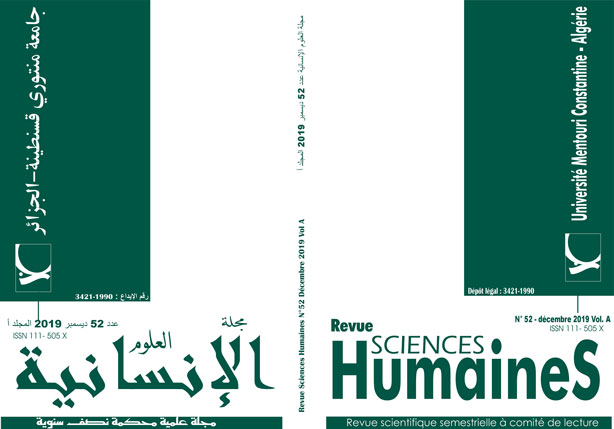Whose Talk is Worth More? A Case Study into Questioning Techniques of Native and Non-Native English-Speaking Teachers
Keywords:
Classroom interaction, teacher talk, questioning strategies, native, non-native teachers.Abstract
Although the native/non-native speaking teacher dichotomy has stirred up ample scholarly consideration and debate in the field of English language teaching, insufficient attention has been devoted to the interactional features that characterize teacher talk, primarily teachers’ questioning behavior. This study sought to determine the extent to which native and non-native English-speaking teachers diverge in terms of the different types of questions they employ in their classes. Accordingly, eight classes of a native and a non-native speaking teacher at the department of English of Constantine Teachers’ College, Algeria, were audio recorded, transcribed and analyzed according to the different types of questions. The analysis of the results reveals that the native-speaking teacher is more inclined toward promoting a genuine classroom interaction by employing more procedural and referential questions along with an extensive use of comprehension checks, whereas the non-native speaking teacher tended to foster students’ participation through an extensive use of display and convergent questions combined with an abundance of clarification requests and confirmation checks.
Downloads
References
McArthur, T. (ed.) (1992) The Oxford Companion to the English Language. Oxford: Oxford University Press.
Brown, T. L. F. (2008). Delivering the sermon: Voice, body, and animation in proclamation. Minneapolis, MN: Fortress Press.
Brumfit, C., & and Mitchell, R. (1989). Research in the Language classroom. London: Modern English in association with the British Council
Chaudron, G. (1988). Second language classrooms: research on teaching and learning. Cambridge: Cambridge university press.
Cook, V. (2008). Second language learning and language teaching (4th Ed.). UK: Hoddereducation.
Davies, A. (2003). The Native Speaker: Myth and Reality. UK: Multilingual Matters Ltd.
Davies, A. (2013). Native Speakers and Native Users: Loss and Gain. Cambridge: Cambridge
University Press.
Ellis, R. (2008). The Study of Second Language Acquisition (2nd ed.). Oxford, UK: Oxford University Press
Gibbons, P. (2006). Bridging Discourses in ESL Classrooms. Students, Teachers and researchers. New York: continuum
Holliday, A. (2006). Native-speakerism. Volume 60, Issue 4. ELT Journal, Pp. 385–387. Doi: 10.1093/elt/ccl030
Hyman, T. R. (1989). Questioning in the College Classroom. In Neff, R. A. & Weimer, M. (Edts.). Classroom Communication: Collected Readings for Effective Discussion and Questioning. Madison, Wisconsin: Magna publications, Inc.
Kayaoğlu, N, M., (2013). Case Study into the Classroom Questions by a Native Speaker and a Non-Native Speaker Teacher in EFL Classes. The Asian EFL Journal Professional Teaching Aticles, 69.
Long, M., & Sato, C. (1983). Classroom Foreigner Talk Discourse: Forms and Functions of Teachers’ Questions. In H. Seliger, & M. Long (Eds.), Classroom-Oriented Research in Second Language Acquisition (pp. 268-286). Rowley, MA: Newsbury House.
Medgyes, p. (1996). Native or non-native: who is worth more? in Hedge and Whitney (eds), power, pedagogy and practice (pp.31-42). Oxford: Oxford University press
Nunan, D. (1990). Second Language Classroom Research. ERIC Digest. ERIC Clearinghouse on Languages and Linguistics Washington DC.
Richards, J. C. & Lockhart, C. (1996). Reflective Teaching in Second Language Classrooms. Cambridge: Cambridge university press.
Sinclair, J. M. & Coulthard, R. M. (1975). Towards an Analysis of Discourse: The English Used by Teachers and Pupils. London: Oxford University Press.
Tsui, A. B.M. (2011). Classroom discourse. In Simpson, J. (Ed.), The Routledge Handbook of Applied Linguistics (pp274-286). New York: Routledge.
Van Lier, L. (1988). The Classroom and the Language Learner: Ethnography and Second Language Classroom Research. New York: Longman Inc.
Walsh, S., (2006). Investigating Classroom Discourse. London and New York: Routledge.
Walsh, S., & Li, L., (2016). Classroom Talk, Interaction and Collaboration (pp.486-498). In Hall, G., (Ed.), the Routledge Handbook of English Language Teaching: London & New York: Routledge.
Downloads
Published
How to Cite
Issue
Section
License
Copyright (c) 2020 Revue Sciences Humaines

This work is licensed under a Creative Commons Attribution-NonCommercial-ShareAlike 4.0 International License.
















